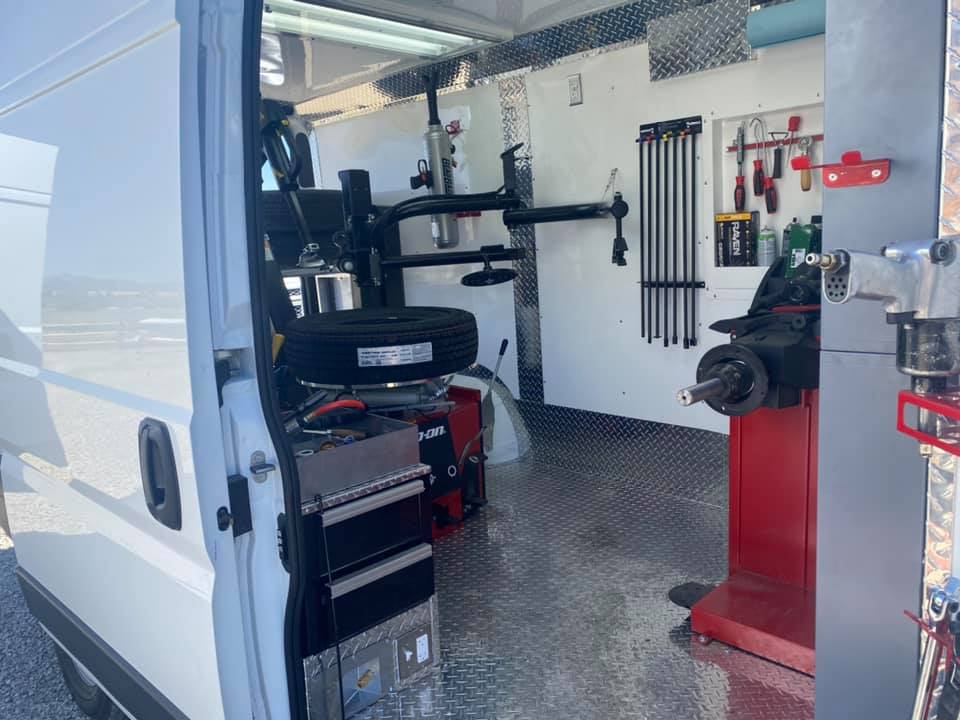Reputable Mobile Tire Change and Replacement in Las Vegas
Reputable Mobile Tire Change and Replacement in Las Vegas
Blog Article
Tire Service: Proven Approaches for Ideal Tire Maintenance and Care
From ensuring correct tire pressure to routine turning and positioning, there are tested methods that can significantly extend the life-span of your tires and boost overall driving experience. Let's dig right into the globe of tire service and find the tricks to maintaining your tires in first-class form for the lengthy haul - Flat Tire Repair Las Vegas.
Significance of Tire Pressure
Appropriate tire stress is a critical consider making sure optimum lorry performance and safety when driving. Preserving the advised tire stress degrees provided by the producer uses many advantages. First of all, appropriate tire stress advertises far better gas performance, as under-inflated tires can bring about raised rolling resistance, creating the engine to function tougher and eat even more gas. Right tire pressure makes sure also walk wear, improving tire durability and saving cash in the long run by postponing the demand for early substitutes. Furthermore, appropriately pumped up tires add to improved handling and braking capabilities, vital for risk-free driving in different road conditions. Over-inflated tires, on the various other hand, can cause lowered grip and a harsher ride. Alternatively, under-inflated tires are vulnerable to overheating, which can lead to accidents and blowouts. On a regular basis examining and changing tire stress, specifically eventually trips, is an easy yet effective way to boost car efficiency, prolong tire lifespan, and focus on safety when traveling.
Tire Turning Standards
When considering tire rotation standards, it is necessary to understand the importance of this upkeep task in taking full advantage of tire life-span and preserving optimal lorry efficiency. Tire rotation includes changing the position of each tire on an automobile to make certain also step wear. Front tires often tend to put on quicker than back tires as a result of guiding pressures, making normal turning vital for well balanced wear patterns. The suggested rotation pattern varies depending on whether a vehicle is front-wheel, rear-wheel, all-wheel, or four-wheel drive. Typically, tires should be rotated every 5,000 to 7,500 miles, or as suggested in the lorry guidebook. Ignoring tire rotation can result in uneven wear, affecting handling, grip, and possibly compromising automobile security. By adhering to proper turning guidelines, chauffeurs can extend the life of their tires, boost gas effectiveness, and enhance total driving experience. Routine rotation is a simple yet reliable maintenance practice that adds substantially to tire longevity and vehicle efficiency.

Advantages of Wheel Positioning
Guaranteeing correct wheel alignment after tire rotation is crucial for preserving well balanced wear patterns and taking full advantage of lorry performance. Wheel positioning describes the adjustment of the angles of the wheels to the maker's requirements. One of the crucial advantages of wheel alignment is boosted guiding and handling action. When the wheels are effectively aligned, it minimizes guiding effort, guaranteeing a smoother and a lot more regulated driving experience. In addition, correct wheel alignment assists to prolong the life-span i thought about this of your tires. Misaligned wheels can create irregular tire wear, bring about premature tire replacement and enhanced maintenance costs.

Tire Footstep Deepness Check
Doing a regular evaluation of tire step deepness is vital for keeping safe driving conditions and extending the life-span of your tires. The tread on your tires plays an important duty in providing traction, particularly in damp or unsafe conditions. To inspect your tire step deepness, you can use a walk depth scale or the dime test. The suggested step deepness is at least 2/32 of an inch. It is time to replace your tires to guarantee ideal efficiency and safety and security on the roadway if the step deepness is below this threshold. Uneven tread wear can indicate problems with tire placement, stress, or suspension, highlighting the relevance of normal step deepness checks. Disregarding to monitor and preserve correct step deepness can cause minimized hold, longer stopping ranges, and a boosted danger of hydroplaning. By integrating tire walk depth look into your routine upkeep routine, you can drive with confidence knowing that your tires remain in leading problem.
Seasonal Tire Inspection
A detailed evaluation of tire condition customized to specific climate condition is critical for preserving optimal performance and security throughout the year. Seasonal tire evaluation is a basic aspect of tire upkeep that ensures tires why not try here prepare to face the difficulties posed by different climate conditions. To prepare for winter, it is necessary to examine the tire pressure regularly as chilly temperature levels can create tire pressure to drop. Evaluating tire tread depth is additionally vital to guarantee appropriate grip on snow and ice-covered roads. Furthermore, examining for signs of deterioration, such as lumps or cracks, can help stop possible tire failings. As the periods change, it is essential to examine tire problem and make any kind of necessary adjustments to ensure risk-free driving. By carrying out regular seasonal tire examinations, drivers can prolong tire lifespan, enhance fuel effectiveness, and most significantly, make sure a safe driving experience in differing climate condition - Mobile Tire Repair Las Vegas.
Final Thought
Finally, keeping correct tire pressure, revolving tires consistently, lining up wheels correctly, monitoring step depth, and performing seasonal assessments are important techniques for ideal tire care. By adhering to these shown approaches, motorists can ensure their tires last much longer, perform far better, and contribute to total automobile safety. It is necessary to prioritize tire upkeep to avoid crashes, enhance gas Read Full Report effectiveness, and lengthen the life expectancy of tires.
Adequate tire stress advertises better gas efficiency, as under-inflated tires can lead to raised rolling resistance, causing the engine to function harder and take in even more fuel.When taking into consideration tire turning standards, it is crucial to understand the value of this upkeep task in making best use of tire lifespan and preserving optimum vehicle performance. Seasonal tire examination is a fundamental element of tire upkeep that ensures tires are prepared to deal with the obstacles posed by different weather condition problems. By performing regular seasonal tire inspections, motorists can lengthen tire life-span, enhance fuel effectiveness, and most significantly, make sure a safe and secure driving experience in differing climate conditions.
In conclusion, preserving appropriate tire pressure, turning tires on a regular basis, straightening wheels appropriately, checking step deepness, and performing seasonal examinations are crucial techniques for optimal tire treatment.
Report this page